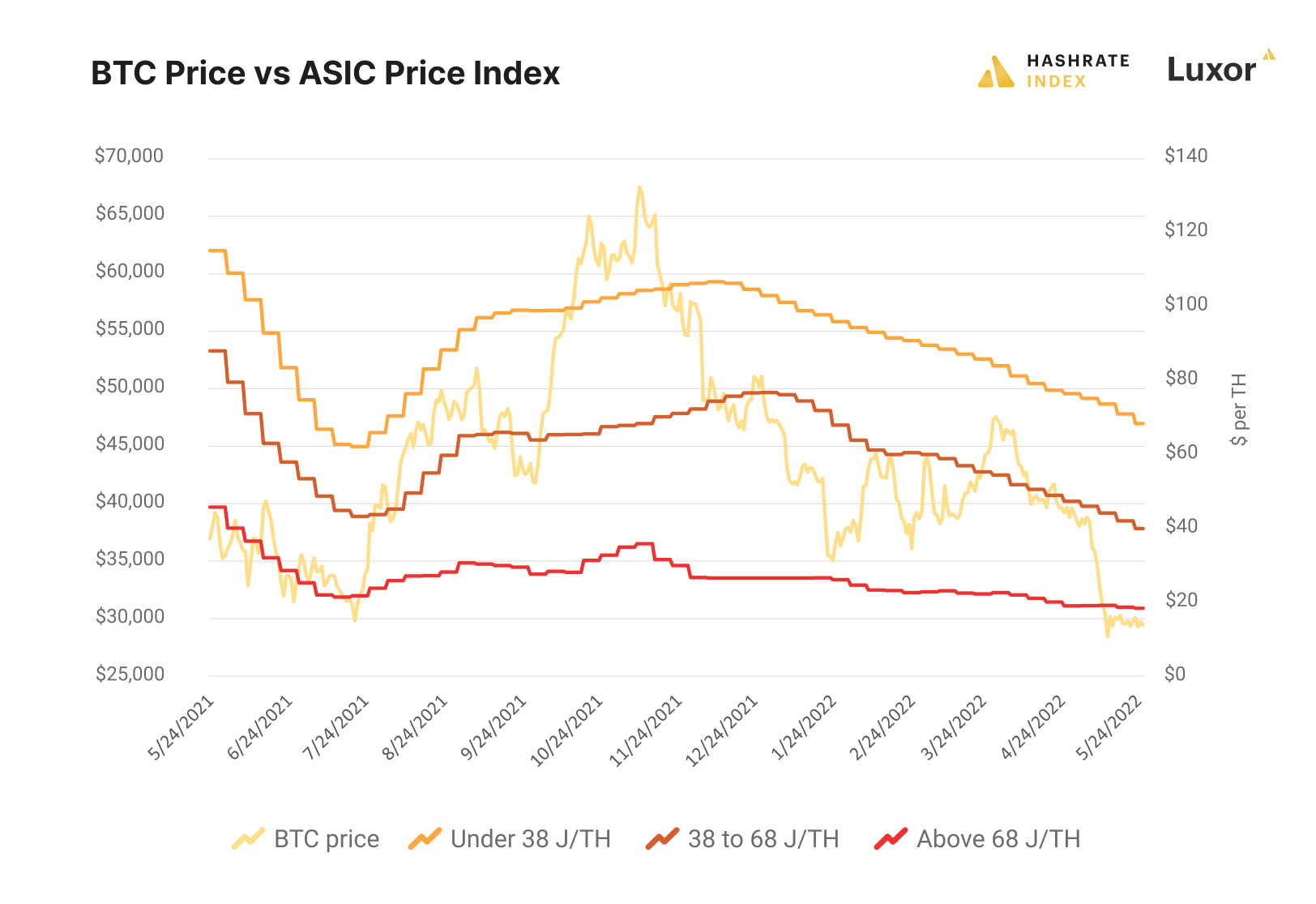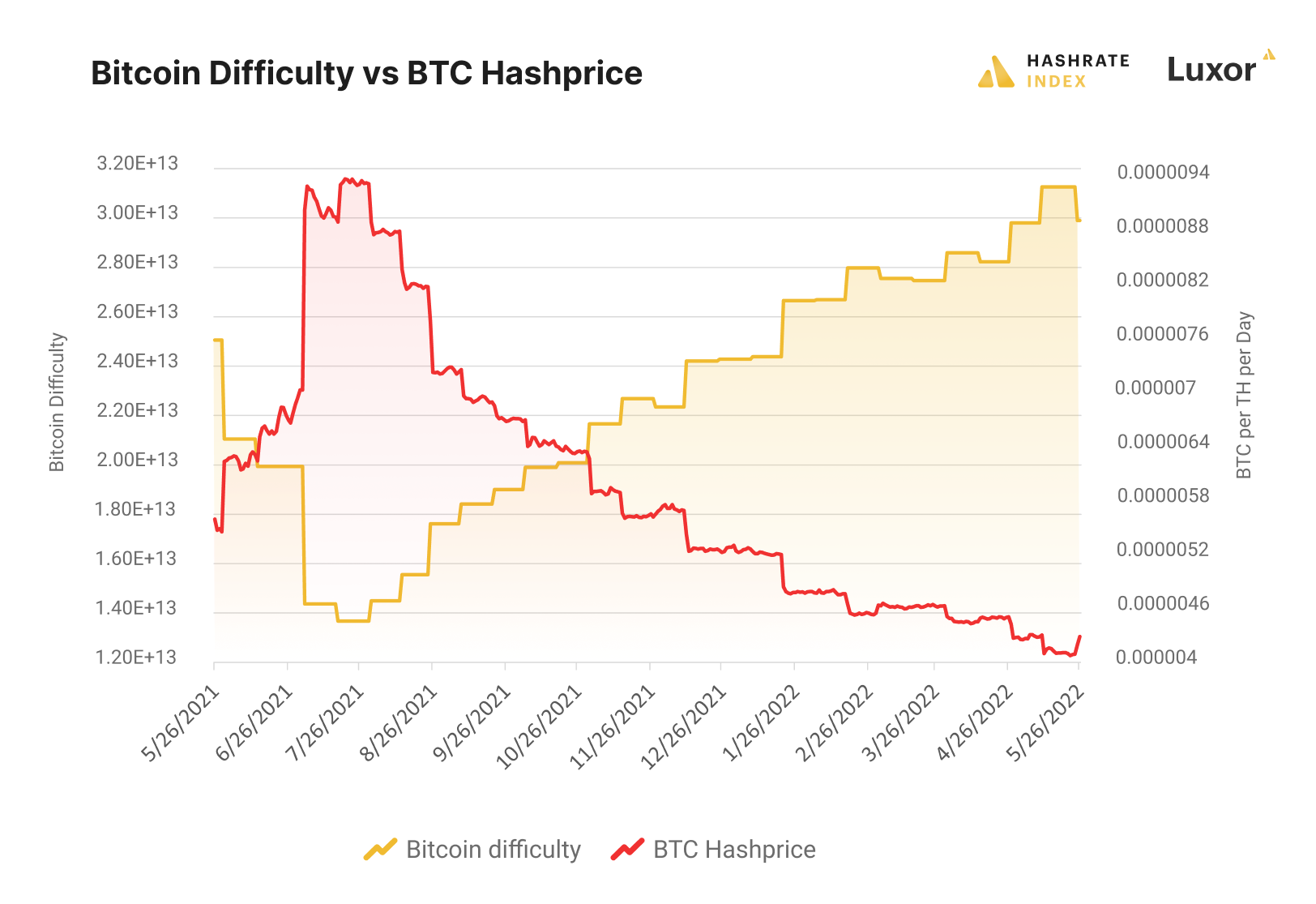
What Will Bitcoin's Hashrate Be by the End of 2022?
Any of y'all know any good oracles? Cause we've got a few questions...
Bitcoin's hashrate made a bit of a U-turn recently.
After hitting an all-time-high of 229 EH/s on the 7-day moving average in the first week of May, 2022, Bitcoin's hashrate has fallen roughly 10% to 207 EH/s.

Over the course of 2022, Bitcoin's hashrate has grown 19%; meanwhile, USD hashprice and BTC hashprice have fallen 50% and 19%, respectively.
In the heat of last year's market action, plenty of folks projected that we'd be at least above 300 EH/s by 2023. But that milestone is looking farther away by the day as mining profitability margins weaken and Bitcoin's price chops around in the $30k range.
Mining economics changed quickly in 2022, and the focus of today's newsletter will be how these new economics might dampen hashrate expansion.
A Bitcoin mining reckoning two years in the making
Before we jump to the data, let’s take a look at the macro background that is driving up energy prices and logistics costs (while also dragging down Bitcoin’s price).
Our story begins in Wuhan–yes really, and no, this isn’t a post about COVID’s origin. It is a story about how COVID (and our global institutions’ reaction to the crisis) shot the world economy full of buckshot but only after inflating the everything bubble even higher.
You know the story. In 2020/2021, central banks and policymakers around the world turned on the money printer in an unprecedented marriage of global monetary and fiscal stimulus. Asset prices went skyward, as did Bitcoin and every aspect of its mining industry, from hardware, to infrastructure, to hosting deals.
Bitcoin’s latest bull-run also coincided with one of the most pivotal events in the Bitcoin ecosystem to date: China’s mining ban. As Chinese miners emigrated out of the former mining hotspot, the United States in particular mopped up a lot of this hashrate and business.
So hashrate started migrating to the states at the same time as a ~0% Fed rate lending environment. Many miners in the US and elsewhere (perhaps overzealously) capitalized on favorable rates and the influx of overseas mining business.
Only, plenty of those miners were executing deals using 2021 profitability, 2021 interest rates, and 2021 ROI models. So what happens now?
Supply Chains, Energy Markets Are Still F*****
Imagine you’re a miner purchasing an S19j Pro for $10,000 last October when hashprice was nearing $0.40/TH/day? Now imagine that the miner just got delivered, and now hashprice is $0.13/TH/day.

The same mismodeling is happening on the energy side, particularly in new must-go mining spots like Texas: miners were building their financial models based on power prices that were significantly cheaper last year than they are now, because gas prices are rising quickly.
Indeed, there are grid stability and capacity issues worldwide. Locational marginal prices (LMPs) are rising in almost every electricity market around the US, and power prices are rising across Europe (even affecting the southern two grid zones of Norway and forcing miners there to shut off).
This is driven by rising gas prices, an increase in renewables energy (which is highly intermittent), and the decommissioning of reliable base loads (primarily nuclear and coal). Additionally, some base loads in certain areas have been less reliable as of late (hydro), and there are other input costs and sources of market volatility (raw material shortages, labor shortages, etc).


Some miners may actually benefit from this energy crunch (or at least survive it) if they are operating in wholesale electricity markets that allow them to use curtailment as a revenue driver (selling power back into the market through a variety of ancillary services products). Other miners, particularly those who are unhedged, or hosted clients with high hosting fees and power costs, risk going underwater as hashprice continues to fall.
That said, increased curtailment (particularly across MISO, PJM, and ERCOT) will drag down Bitcoin's hashrate.
For an example of how this has already slowed growth: the ERCOT Large Flexible Load Task Force is currently reviewing more than 4 GW of interconnection requests; they are also taking a look at reliability issues with a moratorium on new crypto load interconnection requests over 75 MW (front of the meter) or 35 MW (behind the meter) until at least the summer.
In case you're not following along, electricity markets are in for a rocky ride. Read on below 👇🧵
— Titiaan Palazzi (@titiaan_palazzi) May 24, 2022
CC @ArnoHarris, @apoorv_bh89
Problems in energy markets aside, global supply chains are still reeling from COVID’s accordion effect on logistics and supply / demand, so air/sea shipping rates are elevated and inventories are still playing catch up. The effects of this are twofold: High shipping rates are effectively an additional tax on miners procuring ASICs, and supply chain/shipping disruptions translate into long lead-times to get machines plugged in.
Oh, and there's also an incipient diesel shortage percolating right now.
Bitcoin Mining Difficulty and Hashrate: A Love Story
Ok, NOW with that in mind, let’s look at the mining economics side of things. But first, we need to appreciate the fact that the Fed Rate is now standing at a full 1%. Not much, you might think, but it is if your economy/financial industry lives paycheck to paycheck, it's a lot indeed.
With rates rising, BTC has entered a bear market with the rest of the financial system. For miners, rising rates means that we can’t finance ASICs or infrastructure as easily as last year.
So suppressed mining economics means that miners won’t expand as aggressively this year as projected. Indeed, Core Scientific and Bitfarms, for example, have walked back their end-of-year projections.

As we enter a bear market hashprice environment, plenty of miners will see their ROI projections rise (and in some cases, double) because they over-payed for CAPEX last year. Now, energy prices are rising as well, so some miners have seen their OPEX rise and further inflate their ROI timeline.
This doesn't even mention the fact that, as credit becomes more expensive, newer mining operations will be put on pause or scrapped entirely. As such, we expect Bitcoin's hashrate to grow much more slowly this year than most folks expected.
So what do we think Bitcoin's hashrate will be? Here are a few estimates for Bitcoin's 7-day hashrate from the team. Closest by end-of-year gets a trophy in the form of an S9 hashboard.
Bitcoin Hashrate Estimates: January 1, 2023
Luxor team 2023 hashrate projections:
- Nick Hansen: 281 EH/s
- Guzman Pintos: 280 EH/s
- Ethan Vera: 270 EH/s
- Alex Brammer: 260 EH/s
- Colin Harper: 255 EH/s
- Eddie Wang: 250 EH/s
Happy Hashing, and have a great weekend!
Hashrate Index Newsletter
Join the newsletter to receive the latest updates in your inbox.







